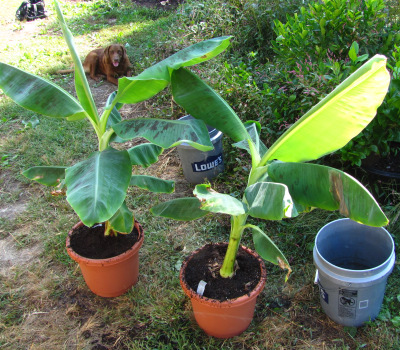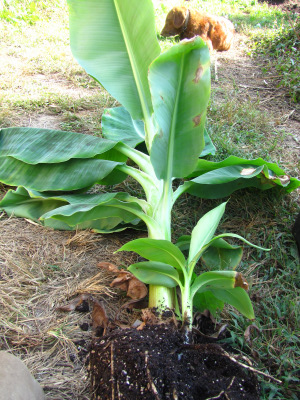
Dwarf Cavendish banana cultivation
 We've
had such good luck with our Dwarf
Meyer
Lemon that we
decided to try out a few other dwarf tropical
fruits. These are all house plants that live outside in pots
during the summer and then come in to sit in a sunny window in the
house through the cold months.
We've
had such good luck with our Dwarf
Meyer
Lemon that we
decided to try out a few other dwarf tropical
fruits. These are all house plants that live outside in pots
during the summer and then come in to sit in a sunny window in the
house through the cold months.
Mostly, we're trying out
different types of dwarf citrus, but Mark
talked me into taking on two Dwarf Cavendish Bananas as well. The
bananas are very pretty plants that many people would consider
 worthwhile
as simple ornamentals, but I'm bound and determined to raise
them all the way to fruiting. If you can pull it off, Dwarf
Cavendish fruits are only a bit smaller than the bananas you buy in the
store, and a single plant can produce up to 90 bananas!
worthwhile
as simple ornamentals, but I'm bound and determined to raise
them all the way to fruiting. If you can pull it off, Dwarf
Cavendish fruits are only a bit smaller than the bananas you buy in the
store, and a single plant can produce up to 90 bananas!
We've only had our
bananas for five months, but I can already tell that
they are a very different beast than lemons. While our lemon
loves light and reaches toward the window, my bananas got sunburned
when I let their beautiful leaves get too close to the glass during the
summer. Lemons can deal with some sub-freezing temperatures
(although too cold weather will make them drop their fruits), but
bananas are supposed to be sensitive to drafts and stop growing below
57 F.
 Although they seem to be more
sensitive than lemons, bananas are quite
easy to propagate since they aren't grafted. From time to time, a
plant will send out an offshoot ("pup") from its base, which can be
teased away from the mother plant during repotting and will grow into
a new
banana. You'll need to take advantage of these pups because your
original banana will eventually produce one huge mass of fruits and
then die. The pups are your next generation, slated to produce
bananas in one to two years under good conditions.
Although they seem to be more
sensitive than lemons, bananas are quite
easy to propagate since they aren't grafted. From time to time, a
plant will send out an offshoot ("pup") from its base, which can be
teased away from the mother plant during repotting and will grow into
a new
banana. You'll need to take advantage of these pups because your
original banana will eventually produce one huge mass of fruits and
then die. The pups are your next generation, slated to produce
bananas in one to two years under good conditions.
While repotting our two
bananas (and separating out our first pup), I
discovered that bananas have a very different root form from
lemons. The latter likes to spread its roots horizontally, but
our banana had instead already sent big roots down to the bottom of the
pot. I'll have to remember to buy deep pots for our bananas
rather than wide.
So far
we're quite pleased with our bananas, but I reserve judgement until I
have a fruit in my hand. Until then, our Dwarf Cavendish Bananas
are yet another Walden Effect experiment.
Save
yourself time and let us do the experimenting for you. Our homemade chicken
waterer kits help you make a poop-free chicken waterer in less than
an hour.
Want more in-depth information? Browse through our books.
Or explore more posts by date or by subject.
About us: Anna Hess and Mark Hamilton spent over a decade living self-sufficiently in the mountains of Virginia before moving north to start over from scratch in the foothills of Ohio. They've experimented with permaculture, no-till gardening, trailersteading, home-based microbusinesses and much more, writing about their adventures in both blogs and books.
Want to be notified when new comments are posted on this page? Click on the RSS button after you add a comment to subscribe to the comment feed, or simply check the box beside "email replies to me" while writing your comment.

I gave my dad a 10 cm (3 ") tall banana plant in late 2004 - he planted it in ever larger pots over 5 years (final size ca. 24 L / 6 Gallon pot) and kept it in his living room (south facing room, with south and east facing windows, large mirrors on west & north facing walls). Average temperature during the heating season was pretty high: around 23°C (72°F). He ended up harvesting 2 banana hands (ca. 7 individual banana fruit - aka fingers) in early 2009. The only sucker (what you refer to as a 'pup') to emerge after the mother plant flowered just flowered over Christmas (2013). Under ideal tropical conditions (2500 mm (98") rain, evenly distributed over the year, average temps between 20-35°C (68-95°F), good soil fertility, lots of space to grow, etc.), a banana plant will produce massive bunches (upwards of 50 kg / 110 lbs) of fruit within as little as 9 months - but don't expect that under suboptimal conditions.
A side note: bananas are not trees in any way shape or form - they are herbs - no woody bits!